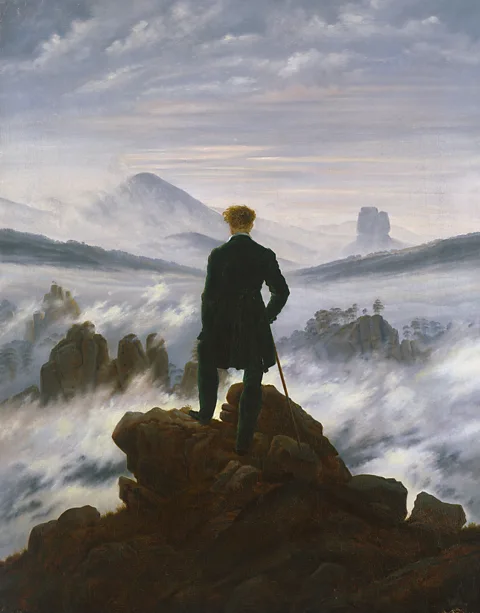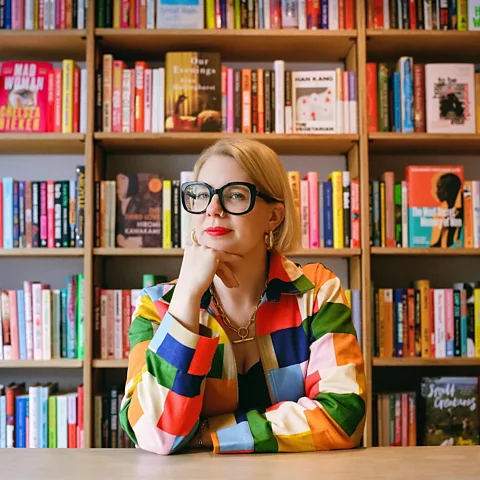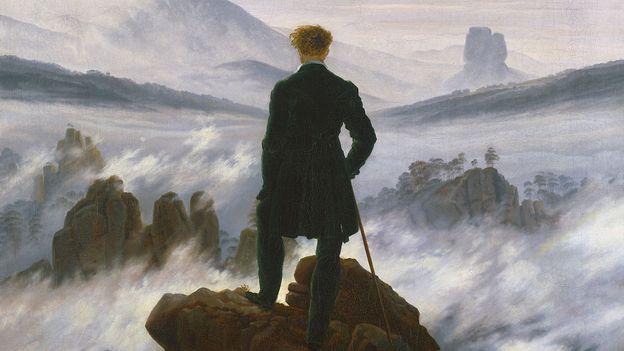 SHK/ Hamburger Kunsthalle/ bpk. Photo: Elke Walford
SHK/ Hamburger Kunsthalle/ bpk. Photo: Elke WalfordFrom spending time by yourself to making the most of being single, flying solo can be fulfilling – a philosophy championed by a new wave of books.
In Wim Wenders’ recent film Perfect Days, the main character, a Tokyo toilet cleaner, spends many of his hours in solitude; watering plants, contemplating, listening to music and reading. While more characters are introduced as the film develops, for many viewers its earlier moments are, indeed, perfect; described by the BBC’s own Nicholas Barber as a “meditation on the serenity of an existence stripped to its essentials“, it really struck a chord. No wonder. Thoughtful and positive outlooks on solitude have been taking up more and more space on our screens, bookshelves and smartphones, from podcasts to viral TikToks. Seemingly, there’s never been a better time to be alone.
In the past couple of years, several titles on the topic have been released, with a few more in the works. Solitude: The Science and Power of Being Alone, and Solo: Building a Remarkable Life of Your Own hit the shelves in 2024, and Nicola Slawson’s Single: Living a Complete Life on Your Own Terms was published in February. Then last month saw the release of Emma Gannon’s much-anticipated novel Table For One; having made her name with non-fiction books questioning traditional ideas of success and productivity, Gannon is now reconsidering modern relationships, in a love story focusing on a young woman finding joy in being alone, rather than with a partner.
 Courtesy of NEON
Courtesy of NEONA shift in attitudes
Packed with keen observations and helpful tips, this new wave of books aims not only to destigmatise solitude, but also to make a case for its benefits and pleasures. Such a powerful stream of publications might come as a surprise, at first, to everyone who has lived through the pandemic and inevitably heard of – or got a bitter taste of – the so-called “loneliness epidemic”, a term popularised in 2023 by then US Surgeon General Vivek Murthy. “Post pandemic, there [was] a huge focus on loneliness, for a really good reason,” says Robert Coplan, a professor in psychology at Carleton University in Ottawa and author of The Joy of Solitude: How to Reconnect with Yourself in an Overconnected World. But because of the concerns about the effects of loneliness, he says, solitude ended up “with a bit of a bad reputation – throwing the baby out with the bath water, so to speak”.
Now, though, the discourse is course-correcting itself. The distinction between loneliness and solitude, according to Coplan, is an important one, and many writers echo this sentiment. “While loneliness is a serious and harmful problem for some people, it is a subjective state very different from solitude, that someone has [actively] chosen for positive reasons,” says journalist Heather Hansen. In 2024, she co-authored the aforementioned Solitude: The Science and Power of Being Alone with Netta Weinstein and Thuy-vy T Nguyen. Hansen had watched the media telling us we’re very lonely for a while; but as a counter to this narrative, she says, “people are reflecting on their own lives and recognising that they are choosing solitude for various reasons that benefit them”.
“I have a theory that since the pandemic we’ve been able to clearly understand the difference between loneliness and chosen solitude,” says Emma Gannon, who is also a big proponent of “slow living”. The extremes of the pandemic – being cooped up with all your loved ones, or, contrastingly, going for months without human contact – had prepared us, Gannon says, “to have nuanced conversations about the differences between isolation and joyful alone time”.
Nestled cosily within these timely conversations is Gen Z-ers and millennials’ re-evaluation of romantic relationships and enthusiastic embracing of single life, alongside a careful reassessment of interpersonal relationships in general. Gannon’s new novel might be a fictional depiction of a young woman reinvesting in a relationship with herself, but it will ring true to many readers who grapple with what are increasingly seen as outdated societal expectations to “settle down”. According to a 2023 US survey, two out of five Gen Z-ers and millennials think marriage is an outdated tradition, and in the UK only just over half of Gen Z men and women are predicted to marry, according to the Office of National Statistics.
 SHK/ Hamburger Kunsthalle/ bpk. Photo: Elke Walford
SHK/ Hamburger Kunsthalle/ bpk. Photo: Elke WalfordIn April, a viral TikTok, with over one million likes and close to 37,000 comments, showcased one man’s perspective on dating women who live alone, and like it this way. Many women deemed the analysis “spot on” and related eagerly. Nicola Slawson, who based Single: Living a Complete Life on Your Own Terms on her popular Substack The Single Supplement, isn’t surprised. “The number of people living alone in the UK has been steadily increasing over the last decade or so,” Slawson points out, with this fuelling a cultural shift towards the acceptance of single people, and putting a focus on “freedom and independence, and especially a rejection of domesticity, as women are realising they don’t have to put up with things they might have been expected to in previous generations”.
Having said that, our cultural fascination with being alone is deeply rooted. Capturing the beauty of solitude has been a focus for numerous artists over the centuries – from German romanticist Caspar David Friedrich, whose great works include Wanderer Above the Sea of Fog, (c. 1817), which can be seen in the Hamburger Kunsthalle art museum’s collection in Germany, to the revered 20th-Century US artist Edward Hopper, and his paintings of solo city dwellers. A New Yorker review of the 2022 Hopper retrospective at the city’s Whitney museum noted, “Everything about the urban life he shows us is isolated, uncommunal – and yet his images of apparent loneliness seem somehow anything but grim, rather proudly self-reliant.”
Daniel Schreiber believes the correlation between people living alone, sans partner, and being lonely has traditionally been overestimated. “Society understands better now that romantic love is not the only model to live by, or something to wish for,” he adds. “There are different ways of life, and it’s not as necessary to be in a traditional romantic relationship.”
In Solo: Building a Remarkable Life of Your Own, Peter McGraw, a self-titled “bachelor”, and professor of marketing and psychology at the University of Colorado, makes a similar point, with gusto. “There’s a lot of mythology around single living, and a failure to understand the reasons marriage was invented – mostly as a business arrangement,” he says. “Frankly, the message of rom-coms, love songs and Jane Austen novels” – that we need a partner to be fulfilled – “isn’t backed by data,” he says, “if we look at the longitudinal data”: many studies cited in Solo show that even if personal happiness spikes around marriage, it doesn’t last.
Even within a relationship, traditional routines can be upended to allow for more alone time, as advocated in The Joy of Sleeping Alone. Its author, yoga and meditation teacher Cynthia Zak, noticed that many women prefer sleeping alone to sleeping in the same bed as their partners, and decided to write the book, originally in Spanish, in order to advocate for “more space to express what we need and feel, more opportunities to let go of fears and limiting beliefs, and more freedom to choose”.
How to be alone well
If being, and doing things, alone is increasingly widespread – and stigma-free – then how does one make the most of it? A couple of key factors everyone agrees on are finding a healthy balance between solo time and communing with others – and having the ability to choose solitude, rather than being forced to experience it. “The greatest indication of success in time alone is that a person has chosen that space believing that there is something important and meaningful there,” says Hansen, adding that solitude is a “neutral blob of sculpting clay; it can be whatever we mould it into”.
Fittingly, according to McGraw it’s perhaps best to not mould said blob into “lying in bed, vaping and ordering Uber Eats”. Rather, he suggests channelling alone time into creative pursuits and pastimes that tend to blossom in solitude; a walk or a run, people-watching at a cafe, going to a museum and “taking it all in, as fast or slow as you can”. Or how about “sitting in a bath listening to Vivaldi”, he adds more specifically, or taking an online course?
 Paul Storrie
Paul StorrieFor those who are single, leaning into potentially blissful solitude – instead of waiting for it to be over – is advised, Slawson says. “I used to find myself putting off doing things until I ‘settled down’ or until I found a partner, but you need to live the life you have got and squeeze as much joy as possible from it instead of feeling like you’re in a waiting room, waiting for your life to start,” she says. And when societal pressure builds? “Don’t default to any type of thinking or a script,” McGraw suggests. “The nice thing is, that there’s now an alternative script.”
More broadly, alone time is full of potential and possibilities. “I think solitude inspires a wonderful sense of creativity, it gets the juices flowing and encourages problem solving,” Gannon says. She suggests treating solitude as an adventure – or a chance to reconnect with yourself, through journalling or revelling in your senses: “The soft blanket, the sound of music, the taste of your food. What can you see, smell, touch and sense when you are alone?”.
Further turning inward, says Zak, can deepen one’s understanding of solitude; she suggests paying attention to moments of solitude, and turning these moments into recurring rituals that aid relaxation and reflection by practice. “Ask yourself, what is the thing that you most enjoy being alone with? Make a jewel of the moment you choose and give yourself the task to cherish this specific space more and more,” she says.
And most importantly, if obviously? It’s about mixing things up. “Humans do need social interaction – but I would also say that humans need solitude,” says Coplan. “It’s finding the right balance that is the key to happiness and wellbeing. Everyone has a different balance that’s going to work for them.”









